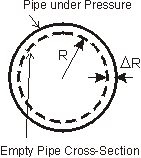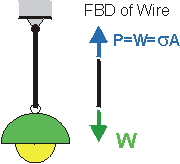Given: A pipe of initial radius R = 0.200 m carries a pressurized liquid that causes the circumferential strain in the pipe to be 0.1% (i.e., the circumference increases by 0.1%).
Req'd: Determine the change in radius of the pipe DR.
Sol'n: Strain e is the change in length divided by the original length. The circumferential strain is 0.1% (0.001). Take L as the circumference of the pipe, and L+D as the circumference under pressure.

e = [(L+D)-L]/L = [2p(R+DR) - 2pR] / [2pR] = DR/R = 1/1000 = 0.001
The radius increases by: DR = R/1000 = (0.2 m)/1000
DR = 0.0002 m = 0.2 mm
